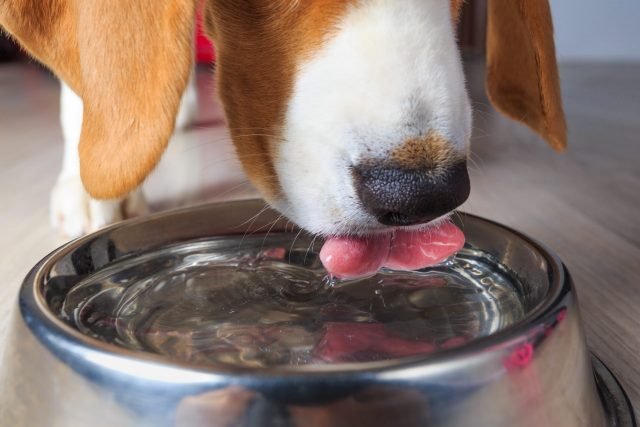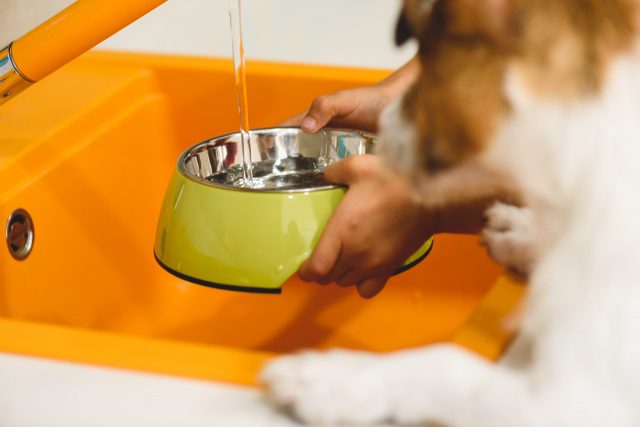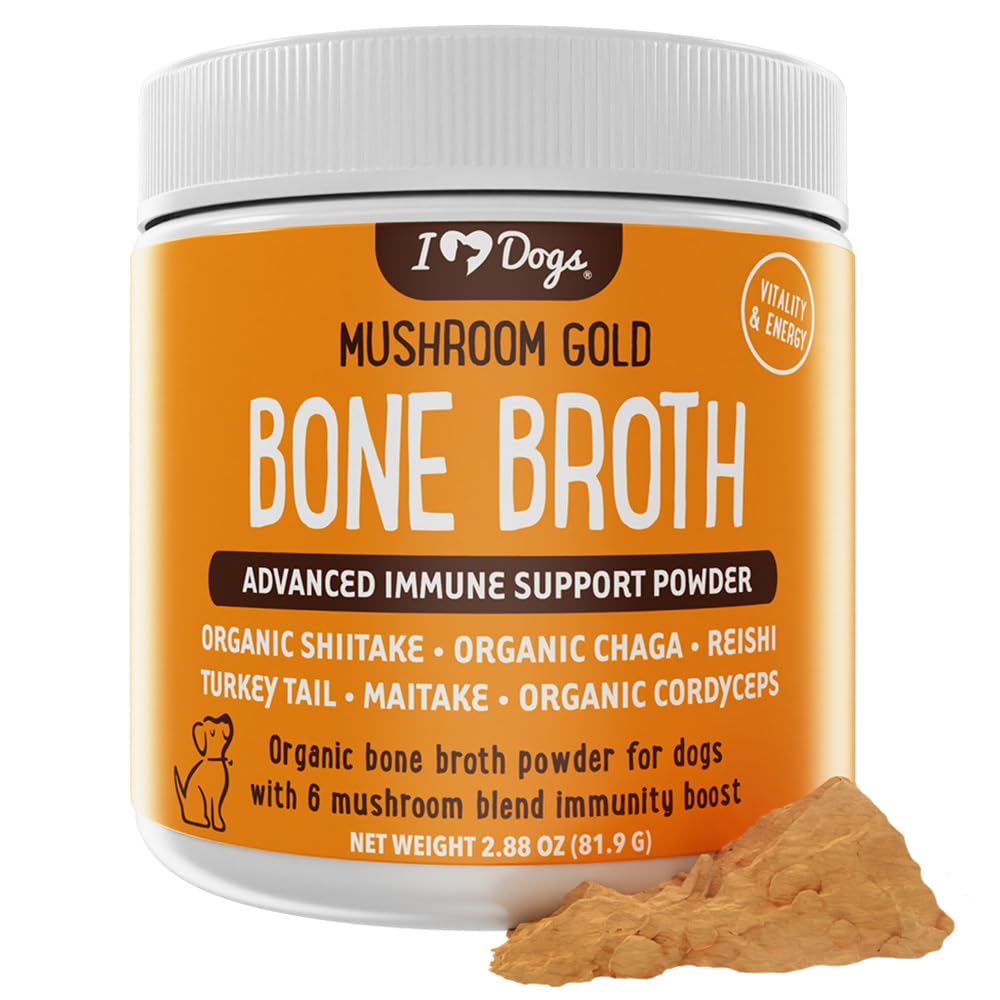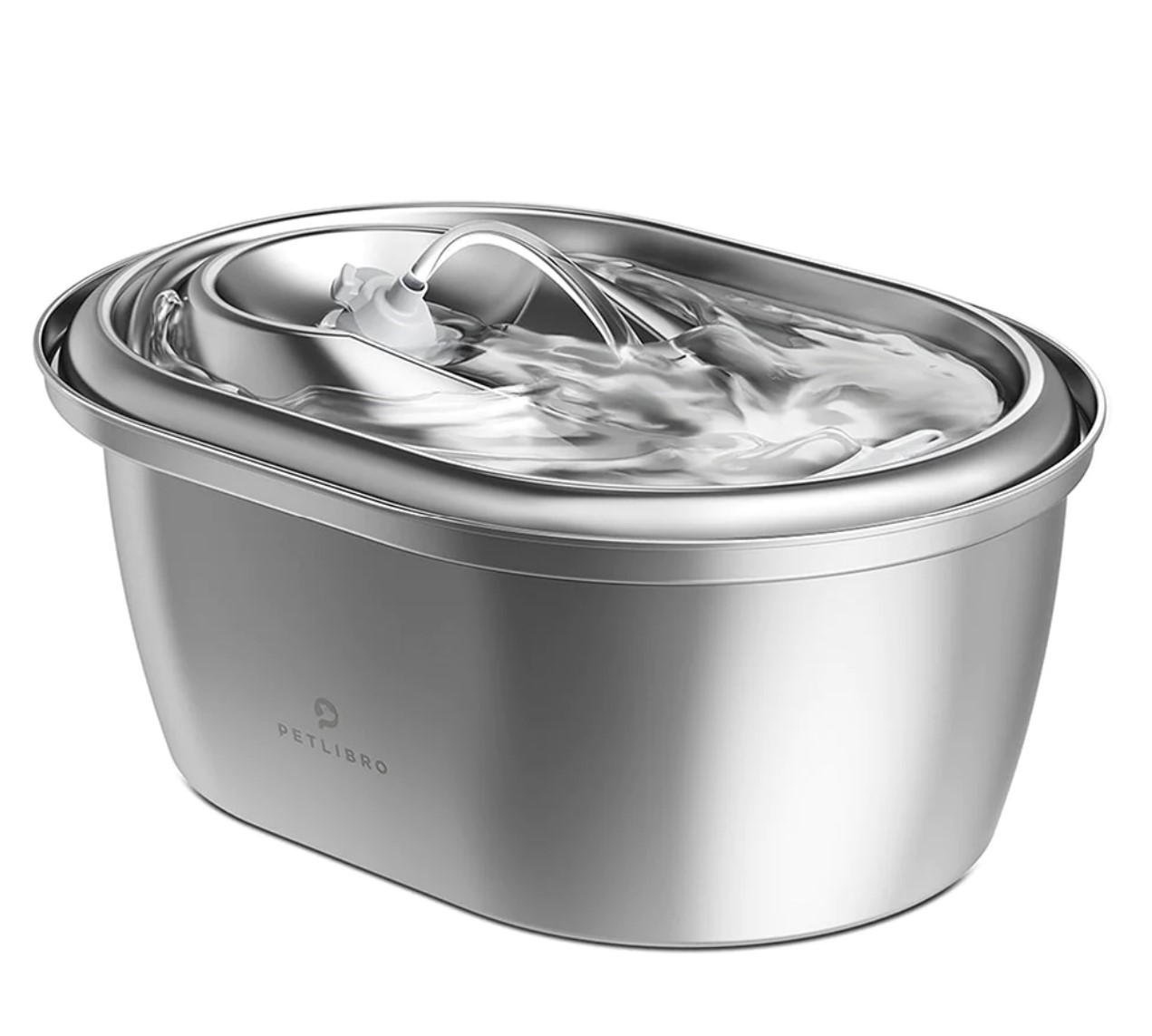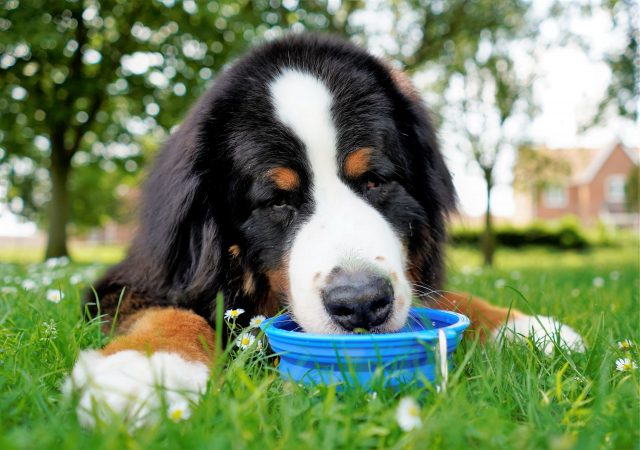iHeartDogs is reader-supported. When you buy via links on our site, we may earn an affiliate commission at no extra cost to you.
Is your dog drinking enough water? In living with dogs, a lot of things can go easily unnoticed. Your dog’s hydration level can be one those sneaky things that fly under the radar. Because dogs generally enjoy drinking water, we don’t always think about dehydration unless it’s really hot outside. But we should be paying attention to our dogs’ water consumption, no matter the weather or the season. Water is one of the important necessities that keeps a body, whether human or canine, functioning properly. Unfortunately, dehydration in dogs is a little more common than you might think.
So, how do you know if your dog is dehydrated? Check out these signs, keeping in mind that some of these symptoms can be a sign of something serious that needs immediate veterinarian attention. First though, let’s talk about how much water should a dog drink a day?
How Much Water Should A Dog Drink A Day?
The amount of water a dog should drink daily varies depending on several factors including size, diet, age, activity level, and environmental conditions. As a general guideline, dogs need about one ounce of water per pound of body weight per day. For instance, a 20-pound dog should drink around 20 ounces of water daily.
- Size Matters: Larger dogs will naturally require more water than smaller dogs. A Great Dane will drink more than a Chihuahua simply due to its size.
- Diet: Dogs on dry food diets will need more water compared to those on wet food diets, as wet food contains a significant amount of moisture.
- Age and Activity: Active, younger dogs and puppies generally need more water than older, less active dogs. Exercise and play increase water needs.
- Environmental Factors: In hot or humid weather, dogs need more water to stay hydrated. Similarly, dogs living in colder climates might not need as much.
- Health: Certain health conditions, like kidney disease or diabetes, can increase a dog’s water requirement. Always consult with your veterinarian if your dog has health issues.
Remember, these are general guidelines, and each dog’s needs can vary. If you’re concerned about your dog’s water intake or notice any sudden changes in drinking habits, consult with a veterinarian for advice tailored to your pup.
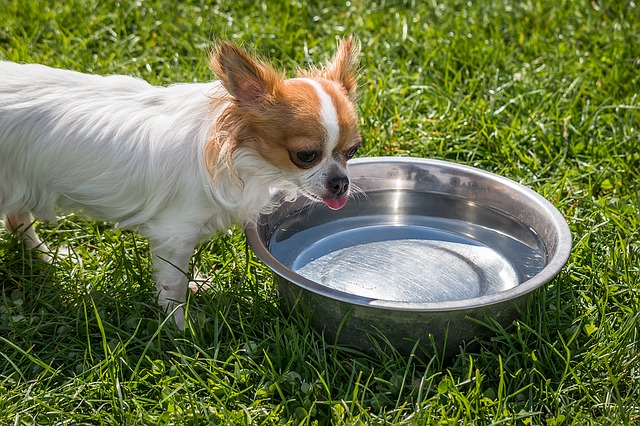
5 Signs Your Dog Needs To Drink More Water
#1 – Vomiting & Diarrhea
Vomiting and diarrhea in dogs can indicate various illnesses, including dehydration. These symptoms worsen dehydration by causing further fluid loss. It’s crucial to monitor your dog closely. If vomiting or diarrhea persists for more than a few hours, it’s essential to consult your veterinarian immediately. Prolonged episodes could signify a severe condition or lead to an emergency, especially if accompanied by signs of distress or weakness.
#2 – Excessive Skin Tenting
Skin tenting is a common way to check for dehydration. It involves gently pulling up the skin to form a “tent” and observing how quickly it returns to its normal position. Delayed return indicates dehydration. Compare your dog’s skin elasticity with examples online that match your dog’s size and weight. Excessive tenting requires immediate veterinary attention as it might indicate severe dehydration or other underlying health issues.
#3 – Lethargy
Lethargy or unusual tiredness in dogs can be a sign of dehydration, as adequate hydration is vital for normal body functions. However, lethargy is also a symptom of numerous other health problems. Any noticeable decrease in your dog’s energy levels or interest in activities should prompt a veterinary examination. In some cases, lethargy can be an emergency, especially if combined with other symptoms like vomiting, diarrhea, or refusal to eat.
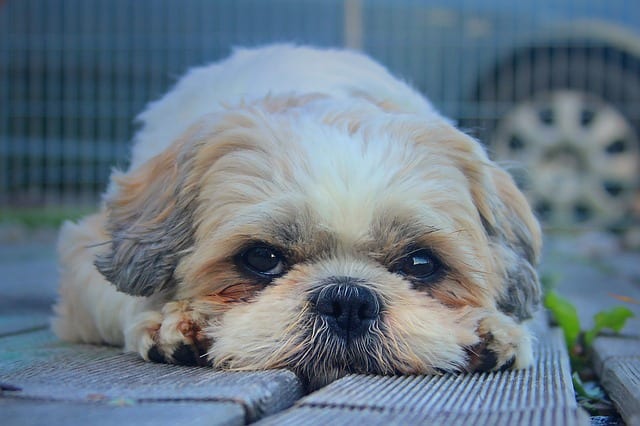
#4 – Dry Mouth
Dry mucous membranes, including a dry mouth and gums, are tell-tale signs of dehydration in dogs. This symptom should never be ignored. If you notice your dog’s mouth is drier than usual, it’s important to see a veterinarian as soon as possible. Dry mucous membranes can also indicate other serious health issues and warrant immediate medical attention.
#5 – Loss of Appetite
A decrease or loss of appetite is often observed in dehydrated dogs. While some dogs can be naturally picky eaters, a sudden disinterest in food is a concern. This can be an indication of feeling unwell due to dehydration or other illnesses. If your dog refuses to eat, especially if accompanied by other symptoms like lethargy or vomiting, it’s imperative to consult with your veterinarian promptly, as this can be an emergency situation.
RELATED: 8 Reasons Your Dog May Not Be Eating
In all cases, it’s better to err on the side of caution. Early intervention by a veterinarian can prevent more serious complications and ensure the best possible outcome for your pet. Remember, these signs can also point to other serious health issues beyond dehydration, and prompt veterinary care is crucial.
9 Ways to Encourage Your Dog To Drink More Water
Dog not drinking water? Time to change that! Encouraging your dog to drink more water is important for maintaining their health, especially if they are prone to dehydration. Here are several effective ways to motivate your dog to increase their water intake:
#1 – Fresh and Clean Water
Maintaining a fresh and clean water bowl is essential for encouraging your dog to drink more water, and crucial for their health. Dogs are more likely to drink when the water is fresh and the bowl is clean, as stale or contaminated water can be off-putting and may even cause health issues. Think about the following on your quest to hydrate your dog:
- Daily Cleaning: Wash your dog’s water bowl daily with hot, soapy water. Rinse it thoroughly to ensure no soap residue remains, as this can deter your dog from drinking. Bacteria and algae can grow in bowls that aren’t cleaned regularly, potentially leading to illnesses.
- Fresh Water: Change the water at least once a day, more often if it becomes dirty. Dogs can leave debris, food particles, and saliva in the water, which can contaminate it quickly.
- Material of the Bowl: Consider the material of the bowl. Stainless steel and ceramic bowls are generally the best options as they are easier to clean and less likely to harbor bacteria compared to plastic bowls, which can develop scratches that are breeding grounds for germs.
Ensuring your dog has access to clean water at all times is a simple yet effective way to promote good hydration habits.
#2 – Multiple Water Stations
Place water bowls in various locations around your home. This accessibility makes it easier for your dog to drink whenever they feel thirsty. Ready to add a couple new water bowls to your dog’s hydration routine? Check out these 31 Best Dog Bowls.
#3 – Flavor the Water
Adding a little bit of low-sodium chicken or beef broth to the water can entice your dog to drink more. Ensure the broth is onion- and garlic-free, as these are toxic to dogs. You can also tempt their tastebuds toward more moisture with iHeartDogs Bone Broth For Dogs Immune Support Powder. Instead of sprinkling it over food, add warm water for a comforting sip!
#4 – Ice Cubes
Some dogs enjoy playing with and chewing on ice cubes. You can add them to the water bowl or offer them directly as a hydrating treat. Not only will this help hydration, but it’s also pretty fun to watch your pup get silly with an ice cube!
RELATED: An Easy Trick For Your Dog’s Water Bowl To Improve Their Dental Health Greatly
#5 – Wet Food
Incorporate wet food into your dog’s diet, as it has a higher moisture content than dry kibble. This can help increase their overall fluid intake. Any of these 6 Best Canned Dog Foods will certainly get them chomping for better hydration.
#6 – Water Fountains
Consider using a pet water fountain with a filter to provide a constant stream of fresh water. The movement of the water can be more appealing to some dogs. Petlibro’s Stainless Steel Water Fountain offers a BPA-free, 304 stainless steel construction that not only lends it a sleek and modern aesthetic but also ensures hygienic water dispensing. The steel material helps to avoid biofilm buildup while making for easy cleaning as this fountain is dishwasher safe. Simply plug it in, and your dog will enjoy a fresh sip of water at every visit.
#7 – Hydration Treats
Provide hydration treats like watermelon (seedless and rindless) or cucumber slices, which have high water content. But moderation is key. While melon and cucumber are healthy snacks for dogs, they should only be given in moderation as a part of a balanced diet. Too much can cause stomach upset, particularly in dogs with sensitive stomachs.
RELATED: 13 Healthiest “People Foods” For Dogs
#8 – Encourage Drinking After Exercise
Always offer water to your dog after physical activities. They are more likely to drink after exerting energy. When you’re on the go, bring a travel water bowl to encourage your dog to drink after play. They’re also handy during outings or car trips. Check out our favorite collapsible travel bowls to hydrate your dog on the go.
#9 – Routine
Dogs love habit and having one centered around consuming more water can help with upping hydration. Establish a drinking routine by offering water at the same times each day, such as after meals, walks, and playtime. Also, visit the water bowl location with your dog frequently to remind them to have a sip.
Final Thoughts on Dogs and Hydration
Recognizing the symptoms of dehydration in dogs is vital for any responsible pet parent. As we’ve explored, signs like vomiting, skin tenting, lethargy, dry mouth, and loss of appetite can all indicate your dog needs more water. By being vigilant and proactive, you can safeguard your dog’s health. Encouraging your furry friend to drink more water can be as simple as ensuring a supply of fresh, clean water, and occasionally using tricks like flavoring the water or incorporating water-rich foods like melon and cucumber into their diet. Remember, these methods are not just about preventing dehydration; they’re part of maintaining your dog’s overall well-being.
A hydrated dog is a happy, energetic, and healthy dog, and by following these guidelines, you’re taking an important step in providing the best care for your best buddy. If you ever have concerns about your dog’s hydration or health, don’t hesitate to consult your veterinarian, as they are your best resource for your dog’s health and well-being.
